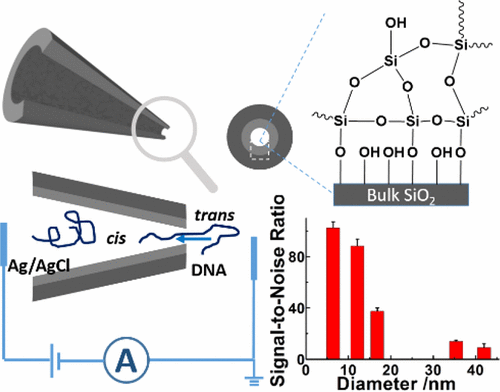Our official English website, www.x-mol.net, welcomes your
feedback! (Note: you will need to create a separate account there.)
Controllable Shrinking of Glass Capillary Nanopores Down to sub-10 nm by Wet-Chemical Silanization for Signal-Enhanced DNA Translocation
ACS Sensors ( IF 8.2 ) Pub Date : 2017-10-17 00:00:00 , DOI: 10.1021/acssensors.7b00385 Xiaolong Xu 1 , Chuanping Li 1, 2 , Ya Zhou 1, 2 , Yongdong Jin 1
ACS Sensors ( IF 8.2 ) Pub Date : 2017-10-17 00:00:00 , DOI: 10.1021/acssensors.7b00385 Xiaolong Xu 1 , Chuanping Li 1, 2 , Ya Zhou 1, 2 , Yongdong Jin 1
Affiliation

|
Diameter is a major concern for nanopore based sensing. However, directly pulling glass capillary nanopore with diameter down to sub-10 nm is very difficult. So, post treatment is sometimes necessary. Herein, we demonstrate a facile and effective wet-chemical method to shrink the diameter of glass capillary nanopore from several tens of nanometers to sub-10 nm by disodium silicate hydrolysis. Its benefits for DNA translocation are investigated. The shrinking of glass capillary nanopore not only slows down DNA translocation, but also enhances DNA translocation signal and signal-to-noise ratio significantly (102.9 for 6.4 nm glass nanopore, superior than 15 for a 3 nm silicon nitride nanopore). It also affects DNA translocation behaviors, making the approach and glass capillary nanopore platform promising for DNA translocation studies.
中文翻译:

湿化学硅烷化可控制收缩至10 nm以下的玻璃毛细管纳米孔,以增强信号的DNA转运
直径是基于纳米孔的传感的主要关注点。但是,直接牵拉直径小于10 nm的玻璃毛细管纳米孔非常困难。因此,有时有必要进行后期处理。在这里,我们展示了一种简便有效的湿化学方法,通过硅酸钠水解可以将玻璃毛细管纳米孔的直径从几十纳米缩小到10nm以下。研究了其对于DNA易位的好处。玻璃毛细管纳米孔的收缩不仅减慢了DNA移位,而且显着增强了DNA移位信号和信噪比(6.4 nm玻璃纳米孔为102.9,优于3 nm氮化硅纳米孔为15)。它还会影响DNA易位行为,从而使该方法和玻璃毛细管纳米孔平台有望用于DNA易位研究。
更新日期:2017-10-17
中文翻译:

湿化学硅烷化可控制收缩至10 nm以下的玻璃毛细管纳米孔,以增强信号的DNA转运
直径是基于纳米孔的传感的主要关注点。但是,直接牵拉直径小于10 nm的玻璃毛细管纳米孔非常困难。因此,有时有必要进行后期处理。在这里,我们展示了一种简便有效的湿化学方法,通过硅酸钠水解可以将玻璃毛细管纳米孔的直径从几十纳米缩小到10nm以下。研究了其对于DNA易位的好处。玻璃毛细管纳米孔的收缩不仅减慢了DNA移位,而且显着增强了DNA移位信号和信噪比(6.4 nm玻璃纳米孔为102.9,优于3 nm氮化硅纳米孔为15)。它还会影响DNA易位行为,从而使该方法和玻璃毛细管纳米孔平台有望用于DNA易位研究。











































 京公网安备 11010802027423号
京公网安备 11010802027423号